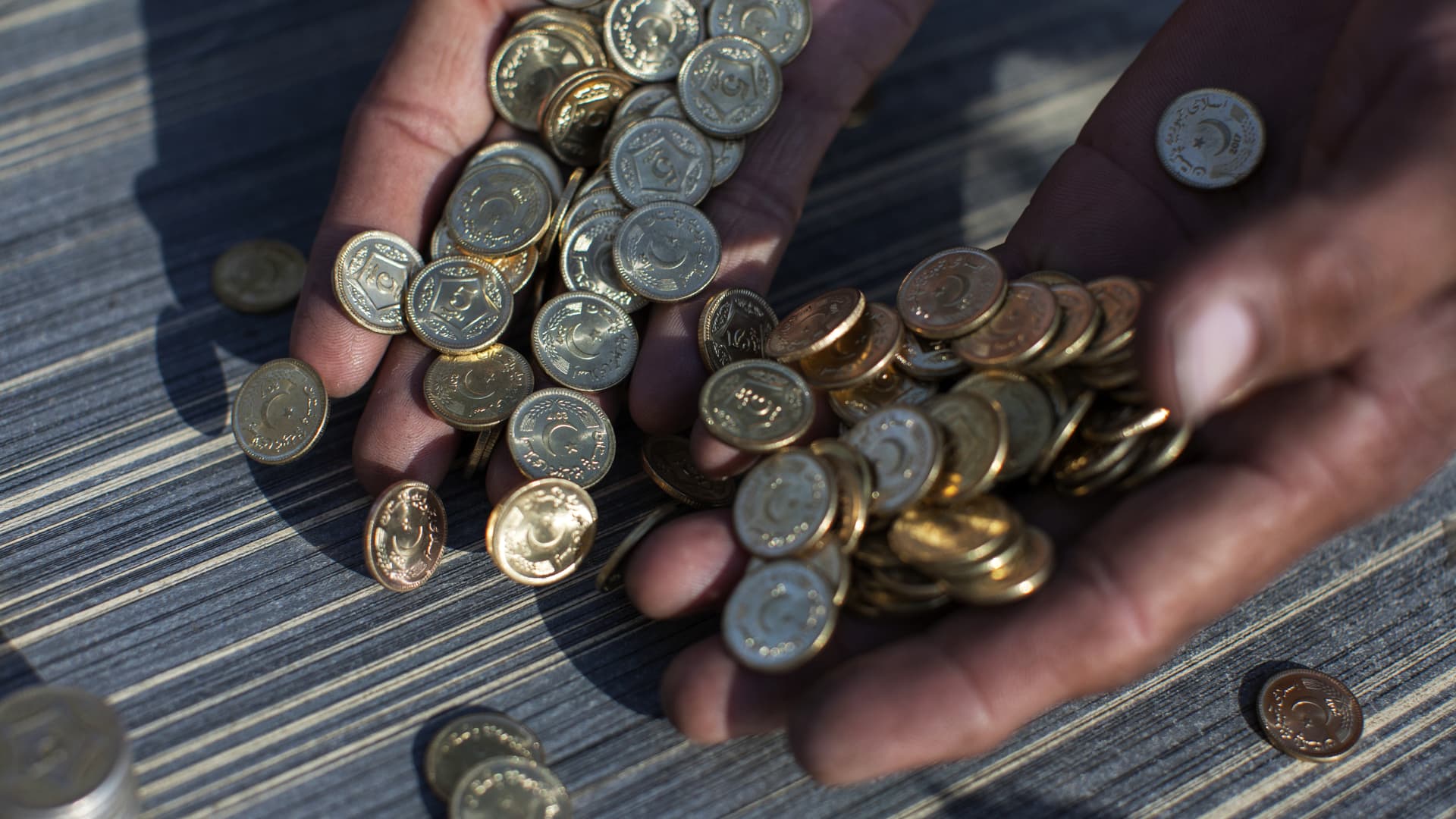A roadside money changer handling Pakistani rupee coins in Karachi, Pakistan.
Bloomberg | Bloomberg | Getty Images
The Pakistani rupee has rebounded from an all-time low to become the world’s top performing currency — and there’s still room to strengthen, analysts say.
The currency plummeted to a record low of 307 rupees against the greenback in early September, according to data from LSEG.
It has since gained over 8% to trade at 275 against the dollar, marking the strongest bounce among other currencies and outpacing them to become the best performer last month.
This was largely owed to a government clampdown on a widespread illicit dollar trade.
“Pakistan’s rupee was the top performer globally this month as a government crackdown on the illegal dollar trade helped reverse its fortunes,” HDFC securities said in a recent report.
The PKR currency is expected to strengthen further, given the continuation of the crackdown and enforcement of the state policy.
Tahir Abbas
Arif Habib Limited
“A remarkable feat as most currencies including the Thai baht and South Korean won tumbled against the dollar on speculation US interest-rates will stay elevated for longer,” the report added.
According to local media, Pakistan’s Federal Investigation Agency embarked on a country-wide raid on exchange companies involved in illegal dollar transactions, which involved the buying and selling of dollars through informal channels without documentation.
“Pakistan rupee remained the world’s best performing currency in the month of September 2023,” Tahir Abbas, head of research at securities brokerage firm Arif Habib Limited, told CNBC via email.
“The PKR currency is expected to strengthen further, given the continuation of the crackdown and enforcement of the state policy,” he predicted.
Abbas said the government should focus on promoting exports and attracting foreign direct investments (FDI) into the country. An increase in foreign direct investment increases the demand for the recipient country’s currency, and boosts its exchange rate.
The Pakistani rupee last traded at 276.19 against the greenback.
Does the rally have legs?
Given the backdrop of Pakistan’s embattled economy, how much of this strengthening is owed to fundamentals?
“The question is whether the rupee rally has been a dead-cat bounce or an indication that its fundamentals are favorable,” said said Steve Hanke, professor of applied economics at the Johns Hopkins University. He noted that geopolitical and internal factors have weighed heavily on the rupee.
Pakistan’s ailing economy has been plagued by crippling debt and depleting foreign reserves. The World Bank estimates that Pakistan’s real GDP for the fiscal year ending 2023 will contract by 0.6%, a reversal as well as a sharp fall from last year’s 6.1% expansion.
Additionally, the country has been grappling with high inflation.
Pakistan’s average headline inflation rose to a multi-decade high of 29.2% year-on-year in FY23, up from 12.2% the previous year, according to the World Bank. The lofty figure was largely owed to the weakness of Pakistan’s currency, reduced domestic fuel and electricity subsidies, and supply chain disruptions, the report said.
Pakistan’s weak currency has, in part, contributed to and fueled inflation. [But] it’s clear that a stronger rupee would dampen inflationary pressures.
Steve Hanke
professor at Johns Hopkins University
Pakistan’s inflation for September jumped to 31.4% year-on-year on the back of high energy and fuel prices, official government data showed.
“Almost 43% of Pakistan’s inflation (CPI) basket is directly related to Pakistan rupee-U.S. dollar parity,” said Abbas from Arif Habib.
Inflation is closely associated with a currency’s value as rising costs reduce the buying power of the currency.
But with the rupee strengthening now, he expects the South Asian nation’s CPI to “ease off a bit but with some lag.”
Hanke echoed the same sentiments.
“Pakistan’s weak currency has, in part, contributed to and fueled inflation. [But] it’s clear that a stronger rupee would dampen inflationary pressures,” he said.
According to data from Arif Habib, the Mauritiun rupee was the second best performing currency in the world, strengthening by 0.7% against the greenback in September, while the Hong Kong dollar took third place, stronger by 0.2% that same month.



















Discussion about this post